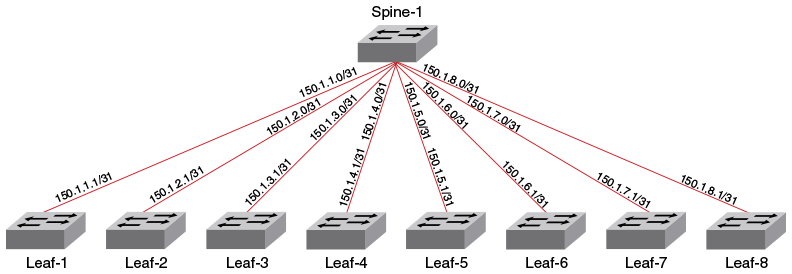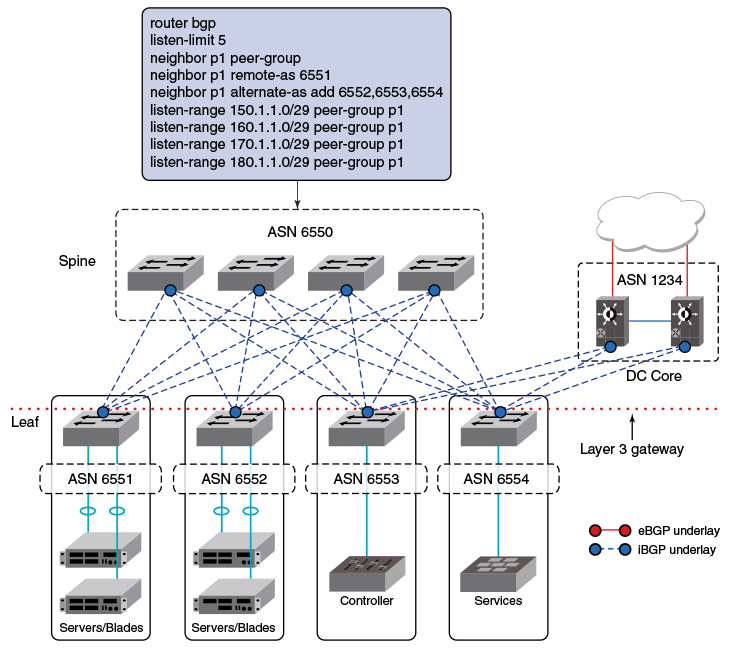BGP Dynamic Neighbors for an IP Fabric
The BGP dynamic neighbors feature allows peering to a group of remote neighbors defined by a listen range. BGP neighbors can be created without statically configuring them.
In a typical data center deployment, a spine has a BGP session with each of the leaf nodes. Typically in this situation, the ratio of spine nodes to leaf nodes is 1 to 4. The greater the number of leafs, the greater the administrative overhead at the spine. Every time a new leaf node is added, specific configurations must be added for each spine node. Moreover, if the IP address used by a leaf for neighboring with the spine node changes, BGP peering information at all spines must be changed. Therefore, as the number of leaf node connections increases, a great deal of administrative work can be required.
The following figure illustrates a typical data center deployment where a spine has a BGP session with each of the individual leaf nodes.

In order for the spine to establish sessions with each individual leaf node, as depicted in the previous figure, a great deal of configuration is needed at the spine level. The following configuration is required at the spine level to establish such a session with the leaf nodes.
device# configure terminal device(config)# router bgp device(config-bgp-router)# local-as 65500 device(config-bgp-router)# neighbor 150.1.1.1 remote-as 65550 device(config-bgp-router)# neighbor 150.1.2.1 remote-as 65550 device(config-bgp-router)# neighbor 150.1.3.1 remote-as 65550 device(config-bgp-router)# neighbor 150.1.4.1 remote-as 65550 device(config-bgp-router)# neighbor 150.1.5.1 remote-as 65550 device(config-bgp-router)# neighbor 150.1.6.1 remote-as 65550 device(config-bgp-router)# neighbor 150.1.7.1 remote-as 65550 device(config-bgp-router)# neighbor 150.1.8.1 remote-as 65550 device(config-bgp-router)# address-family l2vpn evpn device(config-bgp-evpn)# neighbor 150.1.1.1 activate device(config-bgp-evpn)# neighbor 150.1.2.1 activate device(config-bgp-evpn)# neighbor 150.1.3.1 activate device(config-bgp-evpn)# neighbor 150.1.4.1 activate device(config-bgp-evpn)# neighbor 150.1.5.1 activate device(config-bgp-evpn)# neighbor 150.1.6.1 activate device(config-bgp-evpn)# neighbor 150.1.7.1 activate device(config-bgp-evpn)# neighbor 150.1.8.1 activate
With BGP dynamic neighbors, the previous configuration is reduced to the following configuration.
device# configure terminal device(config)# router bgp device(config-bgp-router)# local-as 65500 device(config-bgp-router)# neighbor pg1 peer-group device(config-bgp-router)# neighbor pg1 remote-as 65550 device(config-bgp-router)# listen-range 150.1.0.0/16 peer-group pg1 limit 8 device(config-bgp-router)# address-family l2vpn evpn device(config-bgp-evpn)# neighbor pg1 activate
When BGP dynamic neighbors is enabled for a spine, a BGP subnet listen range (a subnet range address that the IP address of all connected leafs falls under) is configured. Leaf switches are added as BGP peers based on the listen range. The following figure illustrates the minimum configuration needed for a single spine to enable BGP dynamic neighbors.

When eBGP peers have similar configurations, the remote AS number (ASN) cannot be configured as part of the peer group because each peer has its own AS number. For static eBGP peers, a remote ASN must first be configured and then attached to the peer group. For BGP dynamic neighbors, you can configure an alternate AS range; an AS range under which the eBGP peer can fall for the listen range the peer group is a part of. This alternate range is used only for BGP dynamic neighbors. The previous figure illustrates the configuration for the deployment of dynamic eBGP neighbors.
When an OPEN message is received from a particular peer with an AS number that falls under the range configured for the peer group, it is accepted and a session is formed.
For general information on BGP dynamic neighbors, refer to the BGP4 chapter.

